#nominal scales are discrete
Explore tagged Tumblr posts
Text
feeling my creativity be crushed every time i have to work on Statistics
#what the hell even id Statistics bro#Raw Scores???? X#data? plural. datum? singular#nominal scales are discrete#rambling
3 notes
·
View notes
Text

To their southern neighbours, the great civilizations of the South Kantishian and Kantishian Plateau, they are the northern barbarians - to their northern neighbours, the settled peoples of the Basin, they are mountain barbarians. This unflattering judgment is informed by the Am-Wiek's low population densities, strange patriarchal structures, lack of written language and reliance on hunting. In turn, this judgment shapes the relationships between the great kingdoms and empires and these "barbarians", and in this way, much of the fascinating oral history, rich folklore, impressive dances and other cultural riches of the Am-Wiek remain unknown to foreigners.
Origins
The Am and the Wiek have independent but converging histories. The Am are the most ancient settlers of the region. Of undenau origins, they settled the Northern Kantishian from the Basin plains, something which may still be deduced from the similarities of their languages and those of the Tahen and the Coha. The ancestors of these peoples (let's call them the *-ã) were matrilineal and had a highly gendered bigender social structure, in which male and female antioles had distinct and complimentary roles which were nominally equal. In the *-ã which would become the Am, the harsh environment of the Kantishian range increased the importance of hunting, a traditionally male pursuit. Prestige accrued through familial links to great hunters became increasingly important and eventually resulted in a shift to patrilineality - a stepping stone in the shift to patriarchy, for which the determining factor was increasing influence from the Wiek peoples. The Wiek are a later arrival to the Northern Kantishian, a people of kpikigd descent whose ancestors inhabited the Southern Kantishian and were displaced by the growing power of what would become Ghøwout. Most kpikigd people tend towards patriarchal social structures, and the Wiek's ancestors were no exception. The low population densities of the Northern Kantishian allowed the Wiek's ancestors to settle in the midst of the *-ã, setting the scene for the centuries of close contact which would see these two people become the Am and the Wiek. In the modern day, the Am and the Wiek share much in term of lifestyle, social structures, cosmology, and lineage - while the Am remain notably more ethnically undenau, and the Wiek more kpikidg, to the southern and northern peoples the Am-Wiek and the Oubixwø-øi of the Kantishian plateau form a distinct montagnard ethnicity. These similitude were born of centuries of trade, warfare, competition, collaboration, intermarriage, hatred, and friendship. These complex interactions underlay the life and politics of the Northern Kantishian.
Lifestyle
Am-Wiek are sedentary agriculturalists. They rely heavily on hunting and fishing to supplement their diet, a lifestyle which enforces low populations densities and impedes the formation of cities and large-scale polities. For this reason, the Northern Kantishian is a constellation of small kingdoms and independent villages with unstable politics and complex local identities - neither Am nor Wiek perceive themselves belonging to such a large cultural identity: the division between Am and Wiek has some basis in cultural practice and ethnicity but is mostly rooted in language. In fact, even more discrete divisions based off political structure and cultural practices are rarely used by these peoples themselves, with very local cultural identities (often to the level of a single village) being the most prominent ones. Larger-scale identities such as Akisam, Naihlam, or Highland Tiagwiek mostly appear in higher level political contexts such as between kings or powerful chieftains, or contexts where frictions generates a need for larger scale collaboration, and more often to speak of foes than to speak of allies. Petty warfare between small fiefdoms is a staple of summer life and rarely achieves much lasting geopolitical effects.
Historically, the Am-Wiek have not raised much livestock apart from the diminutive kabi, but this is beginning to change with the introduction of the tsut, a small therizinosaurine livestock imported by the Setse colonists to the West. The adoption of tsut-based pastoralism by Am-Wiek peoples has been slow - the reduced reliance on hunting is perceived as a threat to Am-Wiek values and lifestyles - but the increased population densities enabled by pastoralism suggests that the delicate balance of petty warfare in the Northern Kantishian will undergo significant changes in the decades to come.
Cosmology
Am-Wiek cosmology is a world of spirits, from the small spirits of mundane animals to the powerful First Spirits of legend. Most powerful of all are the World, the Sun, and the Sky Eye, the mother-spirit in the Moon which ensouled the First Spirits. Am-Wiek share their myths and oral histories through tales but also through dances and songs. Dances of the solstices and equinoxes are especially impressive, often involving the best craftmanship and dancers from several villages. The image above illustrates a traditional solstice dance, in which the Owlcat, representing the Hunt, faces off against the Ceratopsian, representing the Warrior. This dances marks the seasonal change in lifestyle: at the Winter Solstice, the Ceratopsian looses, signifying a return to peace and to the winter hunts, and at the Summer Solstice, the Owlcat loses, signifying the return to farming and warfare.
#art by me#worlbuilding#uanlikri#peoples of uanlikri#mountainfolk#antiole#antiole world#antiole fashion#am wiek#am#wiek#owlcat#ceratopsian#the owlcat is in the Wiek style and the Ceratopsian is in the Am style#as much as they can be considered discrete and distinct styles and not a continuum with enormous local variations that is#this is because there is a huge portion of Engwiek ancestry in a lot of what is now Akisam territory
35 notes
·
View notes
Note
@ Hallmark Christmas Movie Awards 2024: maybe the original post has been buried too deep, but out of curiosity & bc i haven’t been following you for long, how do those awards happen? can the community simply choose from christmas movies released that year & you then do all the calculations?
anyway, great categories, i’m making notes 🥰👀
I think that was the 5th year doing the awards and they're always sort of evolving. There's the set categories (there used to be a few more but I've scaled back for my own sanity) and people can nominate anonymously which movies/characters, etc. from the current year were their favorites for that particular category. From those nominations, I narrow it down to the top 6. I start with the ones that were nominated more than once and then try to have a decent variety if there's not clear choices out of the remaining nominations. That's to my discretion but I don't think it sways the votes since there's usually a few that are more favored anyway. Then we have the anonymous vote and winners are announced via gifset. I don't vote unless there's a tie and then I'll choose which one is my favorite.
It's a decent amount of work for me personally but it's fun and people seem to enjoy it.
6 notes
·
View notes
Text

I uploaded another FNF cover, and this time... it's my two OCs, Deadall Burry and TERMINAL ROBO BARRY 900.
It's a cover of Nominal Dingus's Tofu Remix (Tofu, but it's serious), and I don't want to use the original bc why tf do i draw some dumptruck ass???? I ain't doing that crap...
Link here: https://youtu.be/F21HaNBPu_w?si=UkuVPlSDPwcCoN8j
This cover is also a chromatic scale test, and I know that the art sucks, sorry
Original track, "This mf bought me tofu", by "A Random Duck", and mod by SuperiorFox (play it from your own discretion, because it's fucking the suggestive/nsfw type of content)
Original remix (+ official FLP and its visualizer) by Nominal Dingus
20.8 port by kantilor
Starved Eggman and Furnace by revie03 (screw averyavary, bc they're truly disgusting)
Vs Sonic.exe by... idk who owns it actually (but RightBurstUltra created it, and he has done the most damage he ever had in both FNF and Sonic.exe communities)
If anyone wants to take this down, please let me know through DMs or something idk
#fnf#nominal dingus#friday night funkin#creepypasta#oc#starved eggman#furnace#fnf cover#friday night funkin mod#cover#fl studio#original character#sonic.exe#tofu#sonic the hedgehog#sonic cd#serious#thumbnail#meme#fnf mod#deadall burry endfinite#terminal robo barry 900#robo barry#art#deadall burry#villain#idk man i just typed random tags here#vs sonic.exe#prey#fight or flight
5 notes
·
View notes
Text

Quantum Computing in Cybersecurity
Quantum computing is emerging as a transformative force in the field of cybersecurity. Unlike classical computers, which rely on bits, quantum computers use qubits—units that can exist in multiple states simultaneously due to the principles of superposition and entanglement. These unique capabilities allow quantum computers to perform certain calculations exponentially faster than traditional machines, posing both unprecedented opportunities and serious threats to modern cryptographic systems.
One of the most significant impacts of quantum computing lies in its potential to break widely used encryption methods. Algorithms like RSA, ECC (Elliptic Curve Cryptography), and DSA underpin much of the world’s digital security. These algorithms are based on problems that are hard for classical computers to solve, such as integer factorization and discrete logarithms. However, Shor’s algorithm, a quantum algorithm, can solve these problems efficiently. Once large-scale quantum computers become available, they could decrypt sensitive information secured under these systems, rendering current public-key cryptography obsolete.
To address this challenge, researchers are rapidly developing post-quantum cryptography (PQC)—encryption algorithms that are believed to be resistant to quantum attacks. The U.S. National Institute of Standards and Technology (NIST) is actively leading efforts to standardize such quantum-resistant algorithms. Examples include lattice-based cryptography, hash-based signatures, and code-based encryption, which are designed to withstand attacks even from quantum computers. These new methods aim to protect data not only today but also in the future, anticipating a world where quantum technology is mainstream.
On the other hand, quantum computing also presents new tools for enhancing cybersecurity. Quantum Key Distribution (QKD) is a secure communication method that uses quantum mechanics to encrypt and transmit keys in such a way that any attempt to eavesdrop would be immediately detectable. QKD enables the creation of unbreakable encryption under ideal conditions, making it a promising technology for ultra-secure communication between government, military, and financial institutions.
However, the integration of quantum computing into cybersecurity is not without challenges. The practical deployment of quantum-safe protocols requires extensive changes to existing infrastructure. Moreover, current quantum computers are still in their early stages—known as Noisy Intermediate-Scale Quantum (NISQ) devices—which limits their immediate threat potential. Nonetheless, the concept of "harvest now, decrypt later" is a real concern, where adversaries collect encrypted data today with the intention of decrypting it using quantum systems in the future.
In conclusion, quantum computing is reshaping the landscape of cybersecurity, offering both disruptive threats and novel defenses. Preparing for this future involves a dual strategy: developing and deploying quantum-resistant cryptographic standards while exploring secure quantum-enhanced technologies like QKD. Governments, organizations, and researchers must collaborate to ensure a smooth and secure transition into the quantum era, safeguarding data in a world where computing power is no longer limited by classical constraints.
#QuantumComputing #Cybersecurity #EmergingTech#QuantumThreat #ShorsAlgorithm #EncryptionBreakthrough#PostQuantumCryptography #QuantumSafe #NISTStandards#QuantumKeyDistribution #QKD #UnbreakableEncryption#QuantumRisks #NISQ #DataSecurity#QuantumFuture #SecureTransition #QuantumCybersecurity The Scientist Global Awards
Website link : thescientists.net NominationLink :https://thescientists.net/award-nomination/?ecategory=Awards&rcategory=Awardee Contact Us : [email protected]
___________________________________ Social Media:
Twitter : https://x.com/ScientistS59906 Pinterest : https://in.pinterest.com/scientists2025/_profile/ Tumblr : https://www.tumblr.com/blog/thescientistglobalawards FaceBook : https://www.facebook.com/profile.php?id=6157466213823
0 notes
Text
Global Top 13 Companies Accounted for 82% of total Infrared Glass market (QYResearch, 2021)
Infrared (IR), sometimes called infrared light, is electromagnetic radiation (EMR) with wavelengths longer than those of visible light. It is therefore invisible to the human eye. IR is generally understood to encompass wavelengths from around 1 milli-meter (300 GHz) to the nominal red edge of the visible spectrum, around 700 nano-meters (430 THz).
Infrared Glass refers to allow infrared light to pass through the glass and reduce the loss of infrared light as much as possible. Because not all infrared light can easily pass through the glass. Near-infrared light can pass through glass like visible light, down to around 1.5µm. Glass absorbs around 3µm and above. Infrared glass materials include germanium, zinc selenide, zinc sulfur, magnesium fluoride, calcium fluoride, sapphire, chalcogenide glass, etc.
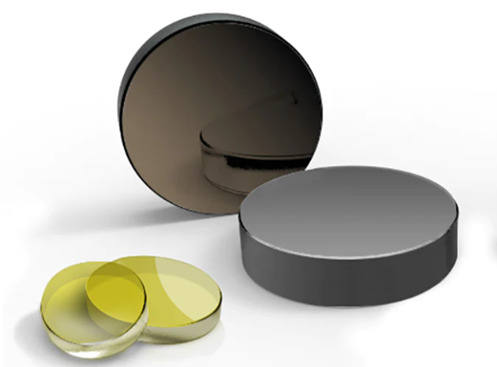
According to the new market research report “Global Infrared Glass Market Report 2023-2029”, published by QYResearch, the global Infrared Glass market size is projected to reach USD 0.35 billion by 2029, at a CAGR of 8.7% during the forecast period.
Figure. Global Infrared Glass Market Size (US$ Million), 2018-2029
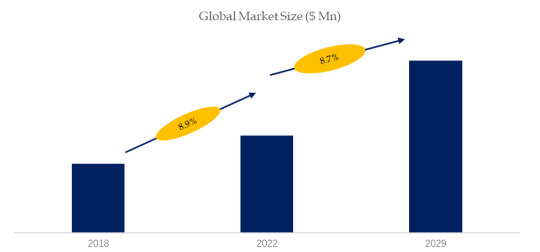
Figure. Global Infrared Glass Top 13 Players Ranking and Market Share (Ranking is based on the revenue of 2022, continually updated)
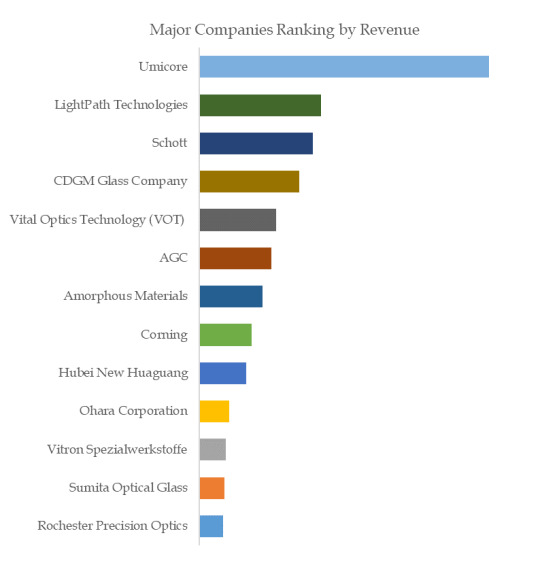
According to the new market research report “Global Infrared Glass Market Report 2023-2029”, published by QYResearch, the global Infrared Glass market size is projected to reach USD 0.35 billion by 2029, at a CAGR of 8.7% during the forecast period.
About QYResearch
QYResearch founded in California, USA in 2007.It is a leading global market research and consulting company. With over 16 years’ experience and professional research team in various cities over the world QY Research focuses on management consulting, database and seminar services, IPO consulting, industry chain research and customized research to help our clients in providing non-linear revenue model and make them successful. We are globally recognized for our expansive portfolio of services, good corporate citizenship, and our strong commitment to sustainability. Up to now, we have cooperated with more than 60,000 clients across five continents. Let’s work closely with you and build a bold and better future.
QYResearch is a world-renowned large-scale consulting company. The industry covers various high-tech industry chain market segments, spanning the semiconductor industry chain (semiconductor equipment and parts, semiconductor materials, ICs, Foundry, packaging and testing, discrete devices, sensors, optoelectronic devices), photovoltaic industry chain (equipment, cells, modules, auxiliary material brackets, inverters, power station terminals), new energy automobile industry chain (batteries and materials, auto parts, batteries, motors, electronic control, automotive semiconductors, etc.), communication industry chain (communication system equipment, terminal equipment, electronic components, RF front-end, optical modules, 4G/5G/6G, broadband, IoT, digital economy, AI), advanced materials industry Chain (metal materials, polymer materials, ceramic materials, nano materials, etc.), machinery manufacturing industry chain (CNC machine tools, construction machinery, electrical machinery, 3C automation, industrial robots, lasers, industrial control, drones), food, beverages and pharmaceuticals, medical equipment, agriculture, etc.
0 notes
Text

DATE & TIME: FEBRUARY 16 - MARCH 16
CHAPTERS: 𝑡ℎ𝑒 𝑑𝑜𝑜𝑚𝑠𝑑𝑎𝑦 𝑟𝑢𝑙𝑒, (𝒅𝒊𝒔)𝒐𝒓𝒊𝒆𝒏𝒕𝒂𝒕𝒊𝒐𝒏, (𝐢𝐧)𝐝𝐞𝐭𝐞𝐫𝐦𝐢𝐧𝐚𝐭𝐞, & the 𝒑𝒉𝒊-𝒕𝒉𝒐𝒏 𝒎𝒂𝒓𝒄𝒉 𝒊𝒔𝒔𝒖𝒆.
FOR PLAYERS: our chapter debriefs are broad summaries of key narratives featured in the listed chapters for players as well as lurkers to follow our story! the admin team utilized players' surveys as well as own notes to create this digest. if you'd like a plotline to be added to this summary, please contact SCiPNET Support on our server. Thank you!
CONTENT WARNINGS: the embedded links contain mild and implicit references to blood, violence, death (incl. parental), gun imagery, PTSD, trauma, religious imagery. Reader discretion is advised.

THE LIGHTS OF DEAD STARS REACHED YOU.
The flight into Site-φ was an affair of superposition, entropy, and Nirvana’s “Heart-Shaped Box.” A mechanical palanquin ferrying the feather destined for psychostasia. 289.6 grams, 284.7 grams, the average weight of the human heart for men and women aged 31-40. Ancient deities wondered how did these souls tip the scales? The answer, dazed and confused.
Severed from Dike, Themis hobbled into lands of snowdrift fir peaks, minimalist architecture, and Jeep Wranglers. Foggy days and dreamless — was it, really? — nights plagued the first few revolutions of the clock. But there was no time to process, not when the hazy light spilled its milky dawn on Orientation Week.
The many faces of the Foundation’s approbations of justice braved each other in a tempered glass menagerie. Mobile Task Force Commander 𝑆𝑀𝑂𝑂𝑇𝐻 𝑂𝑃𝐸𝑅𝐴𝑇𝑂𝑅 addressed the unwieldy handful with cumbersome effort, a grunt unused to the crown thrust upon him by the Ethics Committee.
“I can assure you whatever you've heard is not true — unless it's nice, in which case it is one hundred percent true,” His laugh fell upon the silent company; those who heard about the Committee’s favorite workhorse glowered, and the unaccustomed shifted in their seats, aware enough to sense a shadow in jest. Only a single, fervent apostle listened in rapt attention.
“That being said, I would recommend that everyone try to limit the amount of unnecessary information that they choose to disclose going forward. The Committee has a lot of enemies, so you all need to prioritize your safety. That's all.” The Commander cautioned his group, hoping they’d take some stock into his cue. It’d become an unsuspecting wish ungranted by the stars.
“Who wants to go next?” 𝑆𝑀𝑂𝑂𝑇𝐻 𝑂𝑃𝐸𝑅𝐴𝑇𝑂𝑅 asked. The quiet settled. He restrained a sigh in his throat. “Don’t all jump up at once.”
Whereas veterans of the game eyed for who would make the first move, the initial introductions opened with one of the Foundation’s newest. Hot off the fire, the distracted 𝑄𝑈𝑂𝑇𝐸 𝑈𝑁𝑄𝑈𝑂𝑇𝐸 sprang to life when the group coordinated their focus to him — all but nominating him their paper candidate.
“Well, going off of this very unpleasant attention,” the man pointed out, bobbing up to stand and ditching it to sit again, “…My name's Loch, Doctor Loch, if you want to be an ass. If you're my abuelita, I'm Doctor Matias Rojas, but I don't see her here, so I'm just going to stick with Loch. I really wasn't listening to the format here, so fuck it! I'll freeball it.”
𝑄𝑈𝑂𝑇𝐸 𝑈𝑁𝑄𝑈𝑂𝑇𝐸, once a prisoner of the Foundation and their Sincere Comrades and Partners, tore any metaphorical script issued by his MTFC. The ex-freelance hacker’s skills lay in technology, computers, and software, and he had a vested interest in cryptids like interdimensional Bigfoots. A feint of the heart, the Doctor-not-known-as-Doctor-Loch was committed to keeping in line (while scribbling outside it as much as allowed) to protect his family.
Concluding his proclamation with a sweet shout-out to his cannibalistic pet fish, Hannibal, 𝑄𝑈𝑂𝑇𝐸 𝑈𝑁𝑄𝑈𝑂𝑇𝐸 drew the first of many palms to the frown lines on 𝑆𝑀𝑂𝑂𝑇𝐻 𝑂𝑃𝐸𝑅𝐴𝑇𝑂𝑅’s face. “Ay... Hijo de puta, what did I just say—?”
The consequent orator was a return to Foundation form, versed in regulations and checkmarks. 𝐸𝐿𝐸𝑉𝐴𝑇𝑂𝑅 𝑀𝑈𝑆𝐼𝐶, a modest doctor hailing from the likes of Harvard Medical School and John Hopkins Hospital. She opened with a breezy greeting, “Good morning. I’m Dr. Vera Nair. Elevator Music. Or Dr. Elevator Music, if we’re feeling formal.”
But even soft whiskey-brown eyes on the gentlest doe hid the ancient and unbreakable vigor to ensure survival for their progeny.
“I will use every tool in my arsenal to keep each of you alive,” promised 𝐸𝐿𝐸𝑉𝐴𝑇𝑂𝑅 𝑀𝑈𝑆𝐼𝐶, listing her maxims for doctor-patient conventions. Follow her directions. Do not lie to her. Cover her when she’s working on a teammate. “And for the love of all that is holy, if you must get shot, don’t get shot in the head.”
While the doctor ended on a light-hearted note of three truths and no lies, easing the transition to the next presentation, the unspoken clefs in her lyrical words held a dirge for love lost. Two figures of her past kept their lips sealed like 𝐸𝐿𝐸𝑉𝐴𝑇𝑂𝑅 𝑀𝑈𝑆𝐼𝐶 had for them.
That stillness could not be said for the next speaker. Desiring a grand moment to paint the greatest speeches among her co-workers, 𝐹𝐿𝐼𝑀𝐹𝐿𝐴𝑀 took to the stage. Her notebook audibly snapped shut, transforming into a clapperboard in her head. The starlet scientist spoke, “How heartwarming it is to see so many lovely new faces and charmed to be acquainted with a few of you once more.”
Despite losing her laptop and, thus, her PowerPoint presentation, the infamous researcher wasn’t short on visuals, whipping out her personalized index cards with gilded embossing. Unbeknownst to her captivated-ish audience, 𝐹𝐿𝐼𝑀𝐹𝐿𝐴𝑀 shuffled through the notes with invisible trepidation; her bright demeanor masked the loss of her late parents, Dr. and Dr. Rasquinha from the Department of Mythology and Folkloristics, having known them longer as myths and legends than people.
𝐹𝐿𝐼𝑀𝐹𝐿𝐴𝑀’s index cards instructed her through her speech, prompting for playful little winks, contemplative work ethic pauses, and thought-provoking and inspirational insight that her team would think about for a lifetime. Say it proudly, the card encouraged the showing in delectable orange ink.
The researcher ended her act by inviting the team to contact her, “For any further curiosities, compliments or conversations, please do not hesitate to come and find me. I, Flimflam, would be more than happy to oblige. However please reframe from chitchat with me before my morning cuppa and my evening tea- both important daily rituals where I require my personal time… I look forward to working harmoniously with you all. My lovely team.”
She held for applause and/or standing ovation, but there was none. Critics mentally griped, lost along the meandering scenic route of 𝐹𝐿𝐼𝑀𝐹𝐿𝐴𝑀’s broadcast, or plain tired of the extravagant production of it all. Among them, one in particular expressed her calm judgment in a stare.
Another Themis initiate took the ship’s helm, similarly breezy in their approach like their predecessor, minus the 24-karat bells and whistles. 52 𝑃𝐼𝐶𝐾𝑈𝑃 of previously the Disinformation Bureau broke bread with her new team with seasoned acting, “My name's a bit of a mouthful, so it's easier for all of us if you knew me as Midge. Though, in here, my alias is 52 Pickup — a bit of a mouthful, too, really. Pursuant to protocol, I suppose you could just call me fifty-two.”
The agent humored her age, her display purposefully affable and innocent. To regale, they slipped in a few harmless truths: “…I play the piano, I’m a chain smoker, and I like owls.” 52 𝑃𝐼𝐶𝐾𝑈𝑃 moved on, waving off the spotlight to return to her seat without a preamble. Their unassuming appearance and casual approach worked to great effect, garnering genial interest from ingenue researchers to the perfectly malcontent.
But a few noticed the poker player’s tell, the notes in between the acts. However, their hunches couldn’t be further from the truth. Tucked in the pages of 52 𝑃𝐼𝐶𝐾𝑈𝑃’s notebook was a transplant — a ripped page from another bound tome. The agent smiled in their seat as the next ones introduced themselves, full names and all. 52 𝑃𝐼𝐶𝐾𝑈𝑃 wouldn’t call herself an “enemy of the Committee.”
It was more like a nemesis.
𝐻𝐼𝐺𝐻 𝐹𝐼𝐷𝐸𝐿𝐼𝑇𝑌 was no stranger to the term. In fact, it felt almost suited for the ex-lead Researcher of Site-120’s Thaumatology Division. He had been keeping low since the incident that nearly crippled their career, acting as the model employee for the past three years. The imminent progress toward his unyielding ambition was once again within reach. Shyness was no longer an option.
After all, he wasn’t timid when he received his Ph.D. in Biological and Biomedical Sciences from Harvard. No, the Foundation had sought him out like a heat-seeking missile. When his genius and their ample providence collided, it had been fireworks.
“Greetings, I’m Stephen Wilson. Call me Steve.” The senior supporting researcher had practiced that warm hum, making it sunlight. “…Please don’t be afraid to seek me out for any of your reality-warping needs.” 𝐻𝐼𝐺𝐻 𝐹𝐼𝐷𝐸𝐿𝐼𝑇𝑌 grinned, knowing none were the wiser on what he was capable of.
In fact, some were absolutely besotted with him, others quietly impressed. How droll. Introductions had used to terrify the man — God, as well, in a way. And now, both could be conquered — overruled.
Could the same be said of his sermon’s successor?
Nadia Atalanta, not 𝐿𝐼𝑉𝐸 𝑊𝐼𝑅𝐸, was a bundle of nerves cut loose. Bouncing around departments and mobile task forces since a premature end to a tailor-made role, the reputable tactical response operative found her latest post within the Ethics Committee’s pet project. A position she held with contempt.
“I guess you're supposed to call me Live Wire but I'll probably be a lot nicer if you just go with Atalanta. I've been with the Foundation almost twenty years now, so I can't wait to get the engraved gold watch for that anniversary.”
She made no alms to acquiesce her new coworkers; if anything, it felt like cosmic punishment to face the man who ghosted her among a field of strangers. She had to hold it together and pretend nothing was wrong, that it wasn’t all too familiar to her introductions with the chauvinistic MTF Xi-13. A part of her knew she wasn’t giving Themis a fair shake. However, she had decided.
“If you need me, don’t.”
In 𝐿𝐼𝑉𝐸 𝑊𝐼𝑅𝐸’s mind, her one and only team, Delta-5, was the one she left behind through a series of tragedies. Ever since her brother Mark’s mysterious death surrounding a containment breach that should have never happened, 𝐿𝐼𝑉𝐸 𝑊𝐼𝑅𝐸’s life stopped alongside him. Her previous fast-tracked career halted as she became a pinball rattling around in the machine of the Foundation's Mobile Task Forces.
A former teammate, a military man, a fellow soldier, the architect of one of her little heartbreaks, 𝐷𝑌𝐼𝑁𝐺 𝐵𝑅𝐸𝐸𝐷 sat stony-faced. And the woman 𝐿𝐼𝑉𝐸 𝑊𝐼𝑅𝐸 had shied from, the field doctor, the woman she had dispossessed… 𝐸𝐿𝐸𝑉𝐴𝑇𝑂𝑅 𝑀𝑈𝑆𝐼𝐶 gazed back, saddled with the complicated emotion of dealing with an ex-husband’s sweetheart, one of the people who had left her a widow.
Wow. Sounds like a proper drama on the telly, innit? At the end of the table, unknown to all of this, was 𝑃𝐸𝑅𝐹𝐸𝐶𝑇 𝑆𝑇𝑅𝐴𝑁𝐺𝐸𝑅. He’d tell you they’re an ordinary bloke, a no-name security guard who happened to have been a blind hire for the Foundation’s Site-91. Someone who didn’t aim high, kept their head low, and tried to avoid being killed by something beyond the realms. How he got picked among the Foundation’s talented vets was inconceivable.
𝑃𝐸𝑅𝐹𝐸𝐶𝑇 𝑆𝑇𝑅𝐴𝑁𝐺𝐸𝑅 had actually tried to bomb their Themis interview, and he wasn’t above giving it another go if it meant fewer responsibilities and hassles, along with their life intact. “Not to alarm you, mates, but I am literally the equivalent of a mall cop sitting with you MI6s. The deadliest thing I’ve ever wielded was a heavy-duty torch.” They said, “No hard feelings and such if I'm not a fit.”
Either an act of selfishness or selflessness, the disclaimer about their experience sent a wave throughout the team. 𝑆𝑀𝑂𝑂𝑇𝐻 𝑂𝑃𝐸𝑅𝐴𝑇𝑂𝑅’s facepalm count ticked another on the board. “Ay, no me digas…”
52 𝑃𝐼𝐶𝐾𝑈𝑃, however, enjoyed the absurd comedy of errors… There was no way the Ethics Committee would have made such an overstep by hiring a greenhorn for this project. Was there more to this 𝑃𝐸𝑅𝐹𝐸𝐶𝑇 𝑆𝑇𝑅𝐴𝑁𝐺𝐸𝑅?
In contrast, 𝐷𝑌𝐼𝑁𝐺 𝐵𝑅𝐸𝐸𝐷 was as transparently veteran as they came. However, the experienced soldier’s resume spoke of nomadic gray wolves migrating to and fro a smattering of frontline task force appointments with a history of bucking against the bureaucratic grain.
Here in MTF Chi-00, it was no different. Arriving no earlier than was remotely acceptable to the mandatory meeting, he sat through my-dumbass-callsign-is, and get-to-know-you’s with disinterest. He couldn’t wait to leave from the noise and haunts of his past.
“I’m, ah - Dying Breed. Apparently.” Who knew the Ethics Committee had a sick sense of humor? A grin stretched on his scarred face before the severity of his following statement. “...I’ll do whatever I can to get you out of any trouble you’re in. That’ll be the case even if I don’t like you much. And if all you are is pieces, then - same goes. I’ll get something of you home, if I can.”
It was a promise intended to be upheld, one to which those who knew him could attest. But before anyone else could read any sentimentality behind it, 𝐷𝑌𝐼𝑁𝐺 𝐵𝑅𝐸𝐸𝐷 pulled out a cigarette and snarked, “But chances are you won't hear shit from me until we’re in the field in any kind of way. Or unless this place goes to hell.”
Volunteering a fifteen-minute break for himself without the input of his new commander (and told to come back within five), the tactical operative strode off to the exit, unfazed by surprise admirers and the inquisitive theorists. But something gave the hunter an uncanny sensation when he reached the glass door.
There was a subtle break in the impassive face of the Suit by the door. Something within 𝐷𝑌𝐼𝑁𝐺 𝐵𝑅𝐸𝐸𝐷 repulsed. Fuck that look.
The cavalier airs of the veteran’s exit and re-entry overshadowed the next speaker. №2 𝑃𝐸𝑁𝐶𝐼𝐿 faded in the background. The Site-17 Surrealistics researcher simply did not talk. It was hard to. The brain fog from the flight coming in, the numerous psychiatric evaluations she had cleared prior, the experiment that had gone wrong, and something further, in a place far away, tinged in sepia… Then nothingness. Again. Nothingness.
The crowd eyed her, not knowing what to make of the stoicism. Some did. Regrets washed over 𝐹𝐿𝐼𝑀𝐹𝐿𝐴𝑀, self-monikered reaper of dreams. She had used №2 𝑃𝐸𝑁𝐶𝐼𝐿’s starlight to fuel the golden glory of legacies she could not bear to bury. She had done that to her best friend.
On the other side of the table, a man saw through the twinge within №2 𝑃𝐸𝑁𝐶𝐼𝐿's tranquility. About six months and twenty-three days earlier, 𝑂𝐿𝐷 𝑆𝑃𝑂𝑅𝑇 had known a different woman. And he was set on rescuing her from drowning in her mind.
Braving her own set of waves was the plucky 𝑈𝑅𝐵𝐴𝑁 𝑀𝑌𝑇𝐻. Setting on her maiden voyage in a world that far extended her post with Gamma-6, she felt out of place by how grand the role given to her was and how little the orientation was shaping up to be. The warm comradery of her old seafaring mobile task force was replaced by prejudgment, even derision, in some of these glances around the table.
The levity of her past buoyed her thoughts, and 𝑈𝑅𝐵𝐴𝑁 𝑀𝑌𝑇𝐻 shook them off. This wasn’t a hole to get buried in but an opportunity. Mustering up all of her excitement, she introduced herself to her new life. “I'm a little less Bigfoot,” she quipped, referencing 𝑄𝑈𝑂𝑇𝐸 𝑈𝑁𝑄𝑈𝑂𝑇𝐸, ”And a little more deep-sea mythology. Think I get more seasick on land than on a boat at this point.”
A bright smile hiding her nerves, one of the Foundation’s newest members ended her speech with, “Don’t think we’ll be finding Scylla or Charybdis out here, but I’ve got you covered if we do.” Her sweet nature gathered the group, some pitying her innocence while others reveled in a kindred spirit.
The ensuing lector honed in on the deep-sea operative’s specialty. Was there a possible connection to the ARC in Antarctica? But there was no time to ponder that now — not when it was their turn on the proverbial mic.
They braced themselves. 𝐺𝐴𝑅𝐷𝐸𝑁 𝑉𝐴𝑅𝐼𝐸𝑇𝑌 was not looking forward to introductions. He actually considered it the worst part of meeting new people.
But a few already recognized the man, a height of 6’10” notwithstanding. 52 𝑃𝐼𝐶𝐾𝑈𝑃 and 𝑂𝐿𝐷 𝑆𝑃𝑂𝑅𝑇 knew of the engineer from their past missions, and there was that other scientist from Site-120 within the group… A very familiar face by way of 𝐻𝐼𝐺𝐻 𝐹𝐼𝐷𝐸𝐿𝐼𝑇𝑌.
In terms of science acumen, there was another mind on the opposite spectrum of the two, a researcher notorious for his heart. Though a spot of dizziness hindered him, the AEED junior researcher, 𝐶𝑂𝑊𝐵𝑂𝑌 𝐺𝑅𝐸𝐸𝑇𝐼𝑁𝐺 pushed through to greet his new fellows.
“Hey everybody! I'm – Cowboy Greeting?” The call sign is something he's unused to, and the man places an addendum, “But Seth's fine, whatever you prefer. It's, uh – well...”
The newly-christened 𝐶𝑂𝑊𝐵𝑂𝑌 𝐺𝑅𝐸𝐸𝑇𝐼𝑁𝐺 was a newer acquisition by the Foundation, their previous social work and nonprofit policy evolved to match intra-departmental affairs and policy reviews; a suitable candidate for Themis, by all means. It almost felt fated, then. And perhaps there was more than just trivial coincidence that 𝐶𝑂𝑊𝐵𝑂𝑌 𝐺𝑅𝐸𝐸𝑇𝐼𝑁𝐺 would end up at the Foundation...
Fittingly, the crowd's reaction to Seth-𝐶𝑂𝑊𝐵𝑂𝑌 𝐺𝑅𝐸𝐸𝑇𝐼𝑁𝐺 was quiet, with more intrigue on the basis of the call sign.
For others, social work popped and lingered in their minds, a reminisce of soap after the bubbles. Whereas 𝑈𝑅𝐵𝐴𝑁 𝑀𝑌𝑇𝐻 hoped for that this room and all its inhabitants didn't drain all the caring away, 𝐷𝑌𝐼𝑁𝐺 𝐵𝑅𝐸𝐸𝐷 bristled, inundated with a memory of decrepit couches, battered blinds, and a steel-gray haired woman posing the question: Where's your mom?
(And, without fail, the Watcher looked at him, SCP-4891. Peering as a peer. Wondering what would happen this time.)
Next to the sitting 𝐶𝑂𝑊𝐵𝑂𝑌 𝐺𝑅𝐸𝐸𝑇𝐼𝑁𝐺 was his partner-in-research, the equally anxious but conversely excited doctor, 𝑇𝑅𝐸𝐸 𝐻𝑈𝐺𝐺𝐸𝑅. The two had been whispering throughout introductions, indulging the brief vice of workplace gossip; the epitome of a matching set if the crowd ever saw one. A smile on his lips, he extended line — a connection — to the folks surrounding him.
“I'm Rohan. Just Rohan, please. Dr. Abbasi if you feel especially professionally compelled, but really I'd prefer if we kept things more casual and friendly... You're welcome to call me 𝑇𝑅𝐸𝐸 𝐻𝑈𝐺𝐺𝐸𝑅 if that feels right to you, but you might have to say it a few times to get my attention.” The good doctor explained with a grin, his cheer noticeable that even the solitary №2 𝑃𝐸𝑁𝐶𝐼𝐿 took heed.
“I'm in my seventh year at the Foundation, but it's all been on the research side of things... I'd be more than happy to go into details... as Seth knows I can go on all day about it and then some, but I'll spare you all the gory parts and give you the rundown...”
What 𝑇𝑅𝐸𝐸 𝐻𝑈𝐺𝐺𝐸𝑅 more than excelled in: lab work, neuroscience and pharmacology, amnestic applications in animal and humanoid SCP recovery; he lacked in experience with the Foundation’s other, the militaristic shadow that tinged all of the organization's experiments. In a way, that naivete never really dispersed, and with it came a notorious reputation among the more conservative minds of thought. This researcher would doom them all by consolidation and sympathy of the SCP threat.
Many marveled at the arrival of another big-profile researcher. Whereas 𝐺𝐴𝑅𝐷𝐸𝑁 𝑉𝐴𝑅𝐼𝐸𝑇𝑌 saw a younger self, 𝐻𝐼𝐺𝐻 𝐹𝐼𝐷𝐸𝐿𝐼𝑇𝑌 wasn't listening too closely (at first). But when mentions of amnestics popped up, the scientist knew that there would be a benefit or more if he and 𝑇𝑅𝐸𝐸 𝐻𝑈𝐺𝐺𝐸𝑅 struck a workplace friendship.
However, to one relationship savvy mind in 𝐹𝐿𝐼𝑀𝐹𝐿𝐴𝑀, she could not help but notice just how close the 𝐶𝑂𝑊𝐵𝑂𝑌 and the 𝐻𝑈𝐺𝐺𝐸𝑅 were. Awwwwww talking about Seth Cowboy Greeting during speech…there has got to be something going on there!!!! She jotted her notes, eyes wide with imagination. Tree Hugger + Cowboy Greeting = Bromance?? Tree Hugger + Cowboy Greeting = Dating??? <3 <3
“Onto the next.” Tree Hugger concluded, leaning back into his seat to hear 𝐶𝑂𝑊𝐵𝑂𝑌 𝐺𝑅𝐸𝐸𝑇𝐼𝑁𝐺's encouraging whisper, “Killed it, man. We so got this.”
Lastly, at the end, (at the start) of the circular table was 𝑂𝐿𝐷 𝑆𝑃𝑂𝑅𝑇. A simple, nondescript field agent from Iota-10. One of the best, as noted on his pristine work record. One of the best, as none could really tell you anything of the man. A symbol of the Foundation, made to be invisible.
“...I would request that you all please refer to me by the appointed codename-slash-callsign, 'Old Sport,' as it is one of the precepts of Chi-Zero-Zero.”
The agent requested, soberingly de-personalized compared to all of his predecessors. The air stilled, the building's exhaust fans going silent as a bullet point resumé spoken in an almost artificially generated phrase, with no tonal indication of humor or severity, filled the drab meeting room. It had been said that true neutrality didn't exist, and yet, Themis was witnessing it firsthand.
“I have a multitude of hobbies and like various things. Additionally, I have very few dislikes. I look forward to working with everyone until the very end of this assignment or until reassignments. Thank you.”
The rest of 𝑂𝐿𝐷 𝑆𝑃𝑂𝑅𝑇's presentation took no longer than two minutes, the shortest introduction on the Themis team by far. Contrastingly, emotions ensued from the mild agent's audience. Some of confusion, others of annoyance, and one even postulated there was a murderer in the midst.
But it was 𝐶𝑂𝑊𝐵𝑂𝑌 𝐺𝑅𝐸𝐸𝑇𝐼𝑁𝐺 that felt something prick at his head, disturb his stomach... He knows he has never met someone like Old Sport before, the way the man talks is surreal. But something about Old Sport's face. Something was there.
52 𝑃𝐼𝐶𝐾𝑈𝑃, as well, noticed the tidbits of information packaged with the agent's bland transparency. 𝑂𝐿𝐷 𝑆𝑃𝑂𝑅𝑇 had mentioned the Decommissioning Department, a facility known to be the few who oversaw eliminating SCPs out of existence, as if he was talking about some volunteering he did over the summer. Yes, something was up with the man, and her keen attention caught it — a sliver of disposition that was free from the agent's persona.
Two pairs of hands intertwined with a promise.

MEMORY IS AN IMPORTANT, IMPERMANENT THING.
The Themis operatives have holes in their memory upon arriving to Site-Phi, and the talk of bagels don't help much. As a safety measure during the Themis Interviews, the Foundation administered amnestics from Research and Containment Team Δt to induce memory loss for candidates in case of information leaks, and Osterholz's trigger word has wide-spreading effects throughout the team.
Those in the Foundation who have high resistance to memory alternation have been proven to regain their memories with no issues, such as 𝐶𝑂𝑊𝐵𝑂𝑌 𝐺𝑅𝐸𝐸𝑇𝐼𝑁𝐺, 𝐺𝐴𝑅𝐷𝐸𝑁 𝑉𝐴𝑅𝐼𝐸𝑇𝑌, and 𝑂𝐿𝐷 𝑆𝑃𝑂𝑅𝑇.
While others who handle amnestics in their day-to-day operations may not have experience with these effects themselves, their experience and knowledge of amnestics give them advantages, such as knowing mnemonics or other information retention stratagems. These people slowly understand the state of their mind in the likes of 52 𝑃𝐼𝐶𝐾𝑈𝑃, 𝐸𝐿𝐸𝑉𝐴𝑇𝑂𝑅 𝑀𝑈𝑆𝐼𝐶, 𝐻𝐼𝐺𝐻 𝐹𝐼𝐷𝐸𝐿𝐼𝑇𝑌, 𝑄𝑈𝑂𝑇𝐸 𝑈𝑁𝑄𝑈𝑂𝑇𝐸, 𝑇𝑅𝐸𝐸 𝐻𝑈𝐺𝐺𝐸𝑅, 𝑃𝐸𝑅𝐹𝐸𝐶𝑇 𝑆𝑇𝑅𝐴𝑁𝐺𝐸𝑅, and 𝑈𝑅𝐵𝐴𝑁 𝑀𝑌𝑇𝐻.
But Themis operatives with recent memory issues or cognitive injuries, who are susceptible to cognitohazards, or have been affected by memetic damage, or those who have no experience with amnestics feel even more sick, more confused, more lost... like in the case of 𝐷𝑌𝐼𝑁𝐺 𝐵𝑅𝐸𝐸𝐷, 𝐹𝐿𝐼𝑀𝐹𝐿𝐴𝑀, 𝐿𝐼𝑉𝐸 𝑊𝐼𝑅𝐸, №2 𝑃𝐸𝑁𝐶𝐼𝐿, and 𝑆𝑀𝑂𝑂𝑇𝐻 𝑂𝑃𝐸𝑅𝐴𝑇𝑂𝑅.

SOME ARE NOT ENOUGH TO ASCEND THEIR HUMAN COIL.
Near the end of Themis' acclimatization period, a new candidate in the form of 𝐴𝑈 𝐹𝐴𝐼𝑇 was slated to join the team. One of the Foundation's newest investments, a whistleblower within RAISA who took down her own father. She would be an asset, the Ethics Committee believed. And so they sent her, Vivien, without as much as a heads-up to their so-called favorite.
𝑆𝑀𝑂𝑂𝑇𝐻 𝑂𝑃𝐸𝑅𝐴𝑇𝑂𝑅 woke up wearily to his beeper and met the news with the enthusiasm of a man jolted from sleep in the early hours of morning.
Her foray into her introduction goes well enough, the scent of coffee masking fear and expectation... until it can't.
Themis, before it leaves to its first mission, fractures a little at the edges. Resolutions weaken, minds fray, and spirits break. 𝐸𝐿𝐸𝑉𝐴𝑇𝑂𝑅 𝑀𝑈𝑆𝐼𝐶, №2 𝑃𝐸𝑁𝐶𝐼𝐿, 𝑈𝑅𝐵𝐴𝑁 𝑀𝑌𝑇𝐻, and even 𝐴𝑈 𝐹𝐴𝐼𝑇 herself find that they cannot go on...
There shall be many more. The Foundation has expected this. This is what Humanity has signed up for.
0 notes
Text
Supervised vs. unsupervised learning 101: Key differences and applications
New Post has been published on https://thedigitalinsider.com/supervised-vs-unsupervised-learning-101-key-differences-and-applications/
Supervised vs. unsupervised learning 101: Key differences and applications
In the field of machine learning, there are two approaches: supervised learning and unsupervised learning.
In this article, we will explore the concepts of supervised and unsupervised learning and highlight their key differences.
Types of learning in machine learning
Supervised learning
In this approach, we have labeled data, which means each piece of data comes with a special tag or label.
Supervised learning revolves around the use of labeled data, where each data point is associated with a known label or outcome. By leveraging these labels, the model learns to make accurate predictions or classifications on unseen data.
A classic example of supervised learning is an email spam detection model. Here, the model is trained on a dataset where each email is labeled as either “spam” or “not spam”.
Another instance of supervised learning is a handwriting recognition model. By providing the model with a dataset of handwritten digits along with their corresponding labels, the model can learn the patterns and variations associated with each digit.
Categorical and continuous labels
Categorical labels are used when the target variable falls into a finite number of distinct categories or classes. These labels are also known as nominal or discrete labels.
A categorical label has a discrete set of values. Discrete is a term taken from statistics, referring to outcomes that can only take on a finite number of values, like days of the week. It is like having a limited number of options to choose from.
Continuous labels, also known as numerical labels, are used when the target variable represents a continuous or real-valued quantity. These labels can take on any numeric value within a certain range.
This means that a continuous label does not have a discrete set of values. There can be an unlimited number of possibilities. Think of it like a sliding scale instead of strict categories.
It is important to note that the type of label determines the type of machine learning problem with which you are dealing.
Categorical labels are associated with classification problems, where the goal is to assign a category or class to a given input.
Continuous labels are associated with regression problems, where the goal is to predict a continuous value.
But there are also hybrid problems that involve both categorical and continuous labels, such as multi-label classification or multi-output regression.
Supervised Learning Algorithms
Here are some impressive, supervised learning techniques you should know:
Linear regression
Linear regression is a fundamental technique in machine learning used to model the relationship between a dependent variable and one or more independent variables. It aims to find the best-fitting straight line that represents the linear relationship between the variables.
Linear regression is used in many real-world situations. For example, predicting house prices based on factors like area, number of rooms, and location.
Logistic regression
Logistic regression is employed when the target variable is binary or categorical. It predicts the probability of an instance belonging to a particular class. It is commonly used for tasks such as sentiment analysis or spam detection.
Instead of a straight line like in linear regression, logistic regression uses a special curve called the sigmoid or logistic function. This curve ranges between 0 and 1 and has a characteristic S-shaped form. It maps any input value to a probability value between 0 and 1.
Decision trees
Decision trees are graphical structures that help make decisions or predictions based on a set of conditions. They split the data into branches, where each branch represents a decision or outcome. Decision trees are widely used for classification tasks and can manage both categorical and continuous data.
The decision tree starts with a single node, called the root node, representing the entire dataset. Each internal node of the tree represents a decision based on a specific feature, and each branch represents the possible outcomes of that decision. The leaves of the tree represent the final predictions or outcomes.
Unsupervised learning deals with unlabeled data, where no pre-existing labels or outcomes are provided. In this approach, the goal is to uncover hidden patterns or structures inherent in the data itself.
For example, clustering is a popular unsupervised learning technique used to identify natural groupings within the data.
By applying clustering algorithms to this data, you can identify distinct customer segments based on their similarities. This information can then be used to tailor marketing strategies or personalize recommendations for each segment.
Another compelling application of unsupervised learning is anomaly detection. In cybersecurity, unsupervised algorithms can analyze network traffic patterns that deviate from the norm. By detecting anomalies, potential security breaches or cyberattacks can be preemptively addressed.
Unsupervised learning algorithms
Unsupervised learning algorithms can be classified into two types of problems:
Types of unsupervised learning algorithms: clustering and association
Clustering
One unsupervised learning technique is clustering. Clustering is like a superpower that helps us determine if there are any naturally occurring groupings in the data. It is like finding friends who have similar interests without even knowing their names.
With clustering, you can group similar data points together and uncover meaningful patterns or structures in the data.
There are various clustering algorithms available, such as k-means, hierarchical clustering, and DBSCAN. These algorithms differ in their approaches, but the general idea is to measure the distance or similarity between data points and assign them to clusters. The number of clusters can be predefined (k-means) or determined automatically (hierarchical clustering).
Clustering has numerous applications, including customer segmentation, image recognition, document clustering, anomaly detection, and recommendation systems.
Association
Association is another technique in unsupervised learning that focuses on discovering interesting relationships or associations among different items or variables in a dataset. It aims to identify patterns that frequently appear together in the data.
The most well-known algorithm for association rule mining is Apriori. Given a dataset of transactions, Apriori finds sets of items that occur together frequently and derives association rules from them.
An association rule consists of an antecedent (or left-hand side) and a consequent (or right-hand side), indicating the presence of certain items implying the presence of other items.
For example, in a market basket analysis, association rules can be derived to identify items that are often bought together. These rules can help in making recommendations, optimizing store layouts, or understanding customer behavior.
Both clustering and association are unsupervised learning techniques that help to explore and analyze data without relying on predefined labels or classes. They play crucial roles in pattern discovery, data exploration, and gaining insights from unlabeled datasets.
Conclusion
Supervised and unsupervised learning represent two distinct approaches in the field of machine learning, with the presence or absence of labeling being a defining factor.
Supervised learning harnesses the power of labeled data to train models that can make accurate predictions or classifications.
In contrast, unsupervised learning focuses on uncovering hidden patterns and structures within unlabeled data, using techniques like clustering or anomaly detection.
#algorithm#Algorithms#Analysis#applications#approach#Article#Behavior#binary#classes#clusters#continuous#Cyberattacks#cybersecurity#data#datasets#deals#detection#email#employed#factor#form#Fundamental#hand#hybrid#Image recognition#insights#it#labels#Learn#learning
0 notes
Text
Bonus post: Stats 101 - testing data for normality & significance tests for categorical and continuous variables.
Understanding and analysing data can be a tremendously daunting task, so I thought I would put together a simple go-to guide on how to approach your data, whether it be numerical or categorical. 📈📊
This post will cover:
Types of data
Contingency tables and significance tests for categorical data
Testing for normality in continuous data
Significance tests for continuous variables
NB: Remember to keep your data organised, especially if you are using software packages like ‘R’, MATLAB, etc.
Before I move on, I would like to thank the University of Sheffield core bioinformatics group for most of the content below. 💡
Types of data

There are two main types:
Numerical - data that is measurable, such as time, height, weight, amount, and so on. You can identify numerical data by seeing if you can average or order the data in either ascending or descending order.
Continuous numerical data has an infinite number of possible values, which can be represented as whole numbers or fractions e.g. temperature, age.
Discrete numerical data is based on counts. Only a finite number of values is possible, and the values cannot be subdivided e.g. number of red blood cells in a sample, number of flowers in a field.
Categorical - represents types of data that may be divided into groups e.g. race, sex, age group, educational level.
Nominal categorical data is used to label variables without providing any quantitative value e.g smoker or non smoker.
Ordinal categorical data has variables that exist in naturally occurring ordered categories and the distances between the categories is not known e.g. heat level of a chilli pepper, movie ratings, anything involving a Likert scale.
Contingency tables & significance tests for categorical variables
Contingency tables (also called crosstabs or two-way tables) are used in statistics to summarise the relationship between several categorical variables.
An example of a contingency table:
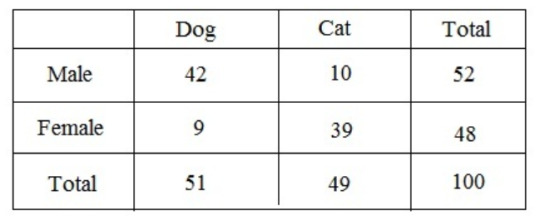
A great way to visualise categorical data is to use a bar plot/chart, which looks something like this:
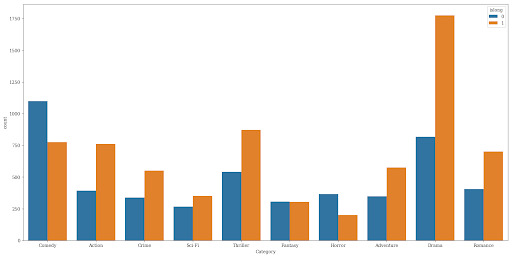
There are two main hypothesis tests for categorical data:
Chi-squared test
Fisher exact test
Chi-squared test:
Compares the distribution of two categorical variables in a contingency table to see if they are related e.g. smoking and prevalence of lung cancer.
Measures difference between what is actually observed in the data and what would be expected if there was truly no relationship between the variables.
Fisher exact test:
Is used instead of Chi-squared when >20% of cells have expected values of <5, or any cell has a count of <1.
If you want to compare several contingency tables for repeated tests of independence i.e. when you have data that you've repeated at different times or locations, you can use the Cochran-Mantel-Haenszel test.
More detail:
In this situation, there are three nominal categorical variables: the two variables of the contingency test of independence, and the third nominal variable that identifies the repeats (such as different times, different locations, or different studies). For example, you conduct an experiment in winter to see whether legwarmers reduce arthritis. With just one set of people, you'd have two nominal variables (legwarmers vs. control, reduced pain vs. same level of pain), each with two values. If you repeated the same experiment in spring, with a new group, and then again in summer, you would have an added variable: different seasons and groups. You could just add the data together and do a Fisher's exact test, but it would be better to keep each of the three experiments separate. Maybe legwarmers work in the winter but not in the summer, or maybe your first set of volunteers had worse arthritis than your second and third sets etc. In addition, combining different studies together can show a "significant" difference in proportions when there isn't one, or even show the opposite of a true difference. This is known as Simpson's paradox. To avoid this, it's better to use the Cochran-Mantel-Haenszel for this type of data.
Testing for normality in continuous data
The first thing you should do before you do ANYTHING else with your continuous data, is determine whether it is or isn’t normally distributed, this will in turn help you choose the correct significance test to analyse your data.
A normal (also known as parametric) distribution is a symmetric distribution where most of the observations cluster around the central peak and the probabilities for values further away from the mean taper off equally in both directions. If plotted, this will look like a symmetrical bell-shaped graph:
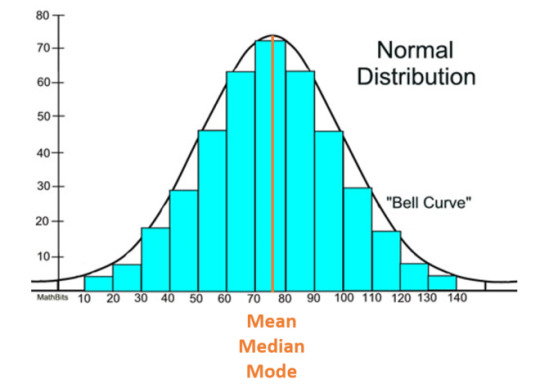
A standard deviation (SD) can be calculated to measure the amount of variation or dispersion of a set of values from the mean. The main and most important purpose of this is to understand how spread out a data set is; a high SD implies that, on average, data points are all pretty far from the average. The opposite is true for a low SD means most points are very close to the average. Generally, smaller variability is better because it represents more precise measurements and yields more accurate analyses..
In a normal distribution, SD will look something like this:
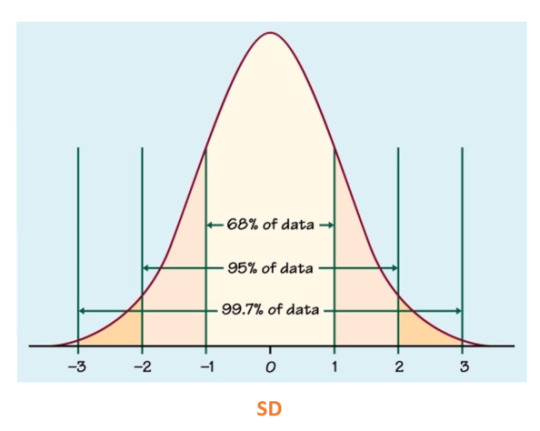
In a normal distribution, skewness (measure of assymetry) and kurtosis (the sharpness of the peak) should be equal to or close to 0, otherwise it becomes a variable distribution.

Testing for normality
Various graphical methods are available to assess the normality of a distribution. The main ones are:
A histogram, which will look something like this:
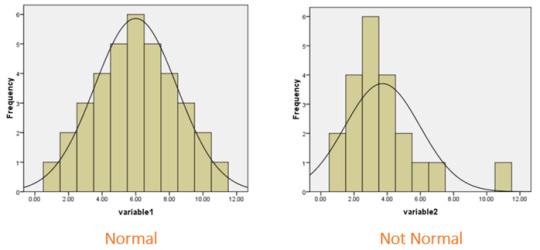
Histograms help visually identify whether the data is normally distributed based on the aforementioned skewness and kurtosis.
A Q-Q plot:
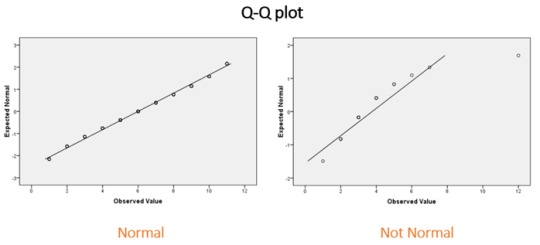
Q-Q plots allow to compare the quantiles of a data set against a theoretical normal distribution. If the majority of points lie on the diagonal line then the data are approximately normal.
and...
A box plot:
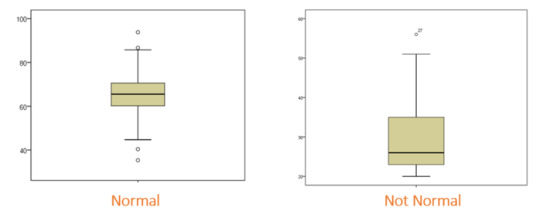
A box plot is an excellent way of displaying continuous data when you are interested in the spread of your data. The thick horizontal bar indicates the median, the top and bottom of the box indicate the interquartile range, and the whiskers represent the spread of data outside of this interquartile range. The dots beyond the whiskers represent outliers, which represent observations that are distant from other observations.
A disadvantage of the box plot is that you don’t see the exact data points. However, box plots are very useful in large datasets where plotting all of the data may give an unclear picture of the shape of your data.
A violin plot is sometimes used in conjunction with the box plot to show density information.
Keep in mind that for real-life data, the results are unlikely to give a perfect plot, so some degree of judgement and prior experience with the data type are required.
Significance tests
Aside from graphical methods, there are also significance tests, which are used to test for normality. These tests compare data to a normal distribution, whereby if the result is significant the distribution is NOT normal.
The three most common tests are:
Shapiro-Wilk Test (sample size <5000)
Anderson-Darling Test (sample size > or = 20)
Kolmogorov-Smirnov Test (sample size > or = 1000)
Significance tests for continuous variables
A quick guide for choosing the appropriate test for your data set:

t-test - normally distributed (parametric) data
There are three types of t-test
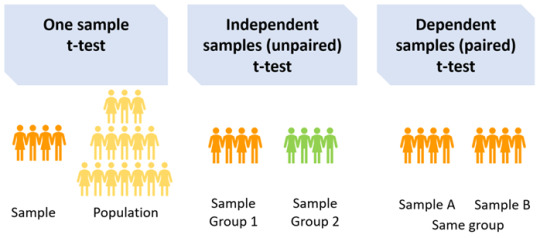
One sample t-test: Compares the mean of the sample with a pre-specified value (population mean) e.g. if the average score of medical students in UK universities is 72 and you want to test whether the average score of medical students in your university is higher/lower, you would need to specify the population mean, in this case 72, when running your t-test.
A two-sample t-test: Should be used if you want to compare the measurements of two populations. There are two types of the two-sample t-test: paired (dependent) and independent (unpaired). To make the correct choice, you need to understand your underlying data.
Dependent samples t-test (paired): Compares the mean between two dependent groups e.g. comparing the average score of medical students at the University of Sheffield before and after attending a revision course, or comparing the mean blood pressure of patients before and after treatment. Independent samples t-test (unpaired): Compares the mean between two independent groups e.g. average score of medical students between University of Sheffield and the University of Leeds, or comparing the mean response of two groups of patients to treatment vs. control in a clinical trial.
There are several assumptions for the independent (unpaired) t-test:
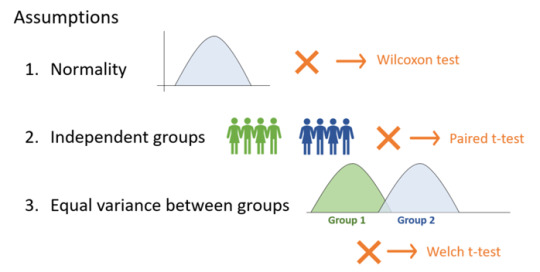
The t-test assumes that the data has equal variance and relies on the data to be normally-distributed. If there isn’t sufficient confidence in this assumption, there are different statistical tests that can be applied. Rather than calculating and comparing the means and variances of different groups they are rank-based methods. However, they still come with a set of assumptions and involve the generation of test statistics and p-values.
Welch t-test, for instance, assumes differences in variance.
Wilcoxon test (also commonly known as the Mann-Whitney U test) can be used when the data is not normally distributed. This test should not be confused with the Wilcoxon signed rank test (which is used for paired tests).
The assumptions of the Wilcoxon/Mann-Whitney U test are as follows:
The dependent variable is ordinal or continuous.
The data consist of a randomly selected sample of independent observations from two independent groups.
The dependent variables for the two independent groups share a similar shape.
Summary of the above:

ANOVA - normally distributed (parametric) data
Like the t-test, there are several types of ANOVA tests:
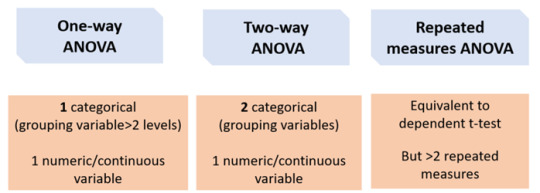
One-way ANOVA:
Equivalent to the independent t-test but for > 2 groups. If you want to compare more than two groups, a one-way ANOVA can be used to simultaneously compare all groups, rather than carrying out several individual two-sample t-tests e.g. to compare the mean of average scores of medical students between the University of Sheffield, the University of Leeds, and the University of Manchester.
The main advantage of doing this is that it reduces the number of tests being carried out, meaning that the type I error rate is also reduced.
Two-way ANOVA: 2 categorical (grouping variables) e.g. comparing the average score of medical students between the University of Sheffield, the University of Leeds, and the University of Manchester AND between males and females.
Repeated measures ANOVA
Equivalent to a paired t-test but for >2 repeated measures e.g. comparing the average score of medical students at University of Sheffield for mid-terms, terms, and finals.
If any of the above ANOVA tests produce a significant result, you also need to carry out a Post-Hoc test.
Post-Hoc test e.g. Tukey HSD
A significant ANOVA result it tells us that there is at least on difference in the groups. However, it does not tell us which group is different. For this, we can apply a post-hoc test such as the Tukey HSD (honest significant difference) test, which is a statistical tool used to determine which sets of data produced a statistically significant result...
For example, for the average scores of medical students between the University of Sheffield, the University of Leeds, and the University of Manchester, the Tukey HSD output may look something like this:

This shows a significant difference between medical students in Manchester and Sheffield and between Leeds and Manchester but not Leeds and Sheffield.
Kruskal Wallis and Friedman tests
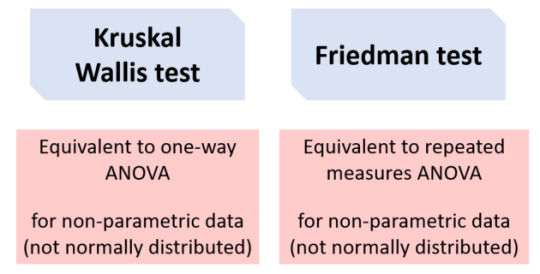
Data that does not meet the assumptions of ANOVA (e.g. normality) can be tested using a non-parametric alternative. The Kruskal-Wallis test is derived from the one-way ANOVA, but uses ranks rather than actual observations. It is also the extension of the Mann-Whitney U test to greater than two groups. Like the one-way ANOVA, this will only tell us that at least one group is different and not specifically which group(s). The Post-Hoc Dunn test is recommended, which also performs a multiple testing correction. For the Friedman test, you can use the Wilcoxon signed-ranks Post-Hoc test. And that is your go-to guide to on how to approach your data! I really hope you find it useful; it definitely helps clarify things for me. ✨
GOOD LUCK!

#diary of a phd student#phd life#phd#bonus post#data analysis#guide#categorical#numerical#data#testing for normality#normal distribution#parametric#non parametric#skewness#kurtosis#science#engineering#ANOVA#t-test#types of data#continuous#discrete#nominal#ordinal#contingency table#chi squared#post hoc tests#kruskal wallis#studyblr#shapiro wilk
88 notes
·
View notes
Photo

Dear friends, for the next three weeks OfHouses will be guest curated by Nicolas Dorval-Bory and Sébastien Martinez-Barat. Nicolas Dorval-Bory and Sebastien Martinez-Barat both founded their own practices (Nicolas Dorval-Bory Architectes, MBL architectes) a few years ago. They both share a common interest in domestic experimentation and alternatives histories. They also belong to the same territory, the rural south of France. Sébastien Martinez Barat (1983) is an architect and co-founder, together with Benjamin Lafore, of MBL architectes. Located in Paris, MBL develops a practice of prospective architecture that finds new and specific ways of operating for each project. Their eclectic approach combine various fields of architecture: construction, publications, object design, curatorial work and academic research. Doubt and enthusiasm inherent to research are balanced by empirical method rooted as well as theories beyond architecture field. In 2014, they created "Interiors. Notes and Figures", the Belgian pavilion 14th Venice Biennale. In 2016, during their residency at Villa Kujoyama in Kyoto, they began a research and construction project entitled "Miscellaneous Folies", which led to an exhibition at Kanal - Centre Pompidou in Brussels in early 2019. In 2016, they were awarded the Albums des Jeunes Architectes et Paysagistes by the French Ministry of Culture, a prize to support outstanding work from emerging architects. Two of their built projects were nominated for the Mies Van Der Rohe Award in 2014 and 2016. Nicolas Dorval-Bory (1980) graduated from the ENSA Paris Val de Seine in 2007. He trained with Andrée Putman and Laurent Deroo before founding his office in Paris in 2008. After collaborations in Chile and Argentina (2009-2010), the office Nicolas Dorval-Bory Architectes operates today in a wide range of scales in France and abroad. More than any dogmatic perspective, its work attempts to address the real with a direct and frontal way, in a rational yet experimental approach considering each project as a climate where the visible and invisible matters generate strong chemicals and physical interactions. In 2016, he has been awarded with the national AJAP prize, from the french Ministère de la Culture, an important biennial recognition for young architects. Nicolas Dorval-Bory has been teaching at the the ENSA Versailles since 2014 and previously at the ENSA Normandy (2011-2014). In 2019, he was invited as a workshop leader at the Porto Acadamy summer school, in Portugal. Nicolas and Sébastien prepared for OfHouses a very consistent selection of houses, published in now in its second part, for which they wrote this short introduction:
Experiments in southern regionalism. Anecdotes from the south.
It seems that the official history of French architecture in the second half of the twentieth century was mostly written in Paris, around major buildings, often from the public commission, and published in national magazines, broadcasted internationally, sometimes defining schools of thought. This history of architecture, the fruit of a political and aesthetic consensus, has come at the expense of another one, made of projects scattered far from Paris, at the edge of cities, in the countryside. A tale of uncertain hypotheses and experiments. A history without heroes. This parallel history is both more daring but also more modest. This narrative simply replaces a saga articulated and unified around canonical figures by a sum of anecdotes. Facts here and there that occur, without any importance or link a priori, but which nevertheless seem to anticipate the doubts and enthusiasms of what architecture today seeks in France. This new tale is necessary for us, because this history might be ours. In retrospect, beyond certain assumed and known filiations (the school of Bordeaux to Jacques Hondelatte, Jacques Hondelatte to Lacaton Vassal), we could trace this history, made of discrete influences, weak and still persistent links of descent, in a certain architecture of the southern half of France, in a localized or diffuse way. Contrary to Parisian history, it is in the domestic way of life, in rural or suburban areas that these experiments will develop. Simple conventional and operational commissions, they nonetheless remain the terrain of attempts to formulate new paradigms on the ways of living, use of materials, energy, economy of means, design processes or more directly on the definition of forms. More than the distinguished architecture, it is these strange houses that marked, in all discretion, our careers and our eyes, but also in a deep and unexpected way, all the recent history of French architecture.
(Cover: Martinez Barat Lafore Architectes & Nicolas Dorval-Bory Architectes /// The Cornell Box /// Villa Noailles, Hyères, France /// 2016-2017. Cover photo: © Lothaire Hucki.)
#OfHouses#oldforgottenhouses#www.ofhouses.com#the collection of houses#Martinez Barat Lafore Architectes & Nicolas Dorval-Bory Architectes#DorvalBoryMartinezBarat2#DorvalBoryMBL
17 notes
·
View notes
Text
NPS Tier II account – Why should you have it?
The National Pension System (NPS) offers two types of accounts: NPS Tier I and NPS Tier II. Tier I is a compulsory pension account while Tier II is an optional facility provided to NPS Tier I account holders which can be opened at the discretion of subscriber.
AD : digitek.net.in
Benefits of NPS Tier II:
1. Ease of account opening: You can activate your NPS Tier II account offline or online through your Nodal Office or NPS Mobile App, provided you have an active and operational NPS Tier I account. NPS Tier II account can be opened with an initial contribution of Rs 1,000 and the minimum subsequent contribution amount for this account is Rs. 250. With the activation of NPS Tier II account, subscribers are free to invest / withdraw whenever they wish to, without any limits.
2. Flexibility to invest: An NPS Tier II subscriber is free to select any of the registered Pension Fund (PF) and Investment Options as like in NPS Tier I account to get the benefit of professional fund management to generate superior returns.
3. Optimal Returns: NPS is a market-linked product and depending on risk appetite of the subscriber, he/she can decide a suitable asset allocation pattern (among Equity, Corporate Bonds and Government Securities) within the prescribed limits to derive optimal returns.
4. Low Cost: NPS carries the benefit of being the lowest cost pension product in the world. The overall costs in NPS are the lowest due to economies of scale in operations of the system architecture. Also, accumulation of the retirement corpus over a period gets accelerated on account of the compounding effect and nominal charges borne by the subscriber.
5. Tax benefits: Exclusive tax benefits on contributions made to Tier II are available for Central Government subscribers subject to lock-in of 3 years, upto Rs 1.5 lakhs under section 80C of the Income Tax Act, 1961. The capital gains arising about of Tier-II investments are taxable at marginal rate.
6. Ease of access and transfer: NPS Tier II account can be operated (including withdrawals) through online/Mobile App. Subscribers are also enabled to transfer funds from his/her Tier II account to NPS Tier I (pension account).
1 note
·
View note
Text
Introduction to Statistics - Brain Mentors
Statistics is one of the major branches of mathematics and stats is one of the biggest reasons behind the success of Data Science, because the methodologies and techniques statistics provides are very helpful for Data Scientist in daily life. Statistical Analysis plays a major role in life cycle of data science.
Definition: Statistics deals with the methods which helps us to gather, analyze, review, and make conclusions from the data. Statistics is used when the data set depends on a sample of a larger population, then the analyst can develop interpretations about the population primarily based on the statistical outcomes from the sample. Like mean, median, mode, range etc.
It comes into the role when a user wants to see the insight of data or wants to find out hidden patterns and it is used in almost every field and department like:
· Weather reports
· In Sports to show players and teams performances
· In TV Channels to perform analysis on TRP
· Stock Market
· Products Based Companies
· Disease and their impact
From very small to very large, each company need statistics to evaluate their growth and how their products perform in market. Let’s see few examples of statistics:
So, these was the few examples of statistics that how everything is being shown to us with the help of graphs and graphs are the best way to show data to users.Before we talk about statistics, first we need to understand data and its different types.
Data and its types:
Categorical Or Qualitative : Categorical data is a type of data which represents categories. Data is divided into two or more categories like gender, languages, cast or religion etc. Data can also be numerical (Example : 1 for male and 0 for female). Here numbers do not represent any mathematical meaning.
Nominal : Type of data that has two or more categories without any specific order. Nominal values represents discrete units and used to label variables that do not have any quantitative value.
Examples :
· Gender – Male and Female
· Languages – Hindi, English, Chinese
· Exams – Pass, Fail
· Grades – A, B, C, D
Ordinal : Type of data that has two or more categories but they have a specific order. Ordinal values represents discrete and ordered units. So it is almost similar to nominal data but they have some specific order.
Examples :
· Movie Ratings : Flop, Average, Hit, Superhit
· Scale : Strongly Disagree, Disagree, Neutral, Agree, Strongly Agree
Numerical Or Quantitative : Numerical data represents continuous type of data which has a mathematical meaning and measured in a quantity.
Interval : Interval type of data represents data in equal intervals. The values of interval variable are equally spaced. So they are almost similar to ordinal type of data but here data could of any continuous range.
Examples :
· Temperature – Generally temperature is divided into equal intervals like 10 – 20, 20 – 30, 30 – 40
· Distance and speed could also be given in equal intervals
Ratio : It is interval data with a natural zero point. When a value of any variable is 0.0 then it means there is none of that value. Suppose you are given temperature and it is 0 degree, so it is valid because temperature could be 0 degree. But if I say that your height is 0 ft then it doesn’t mean anything.
Let’s Dig into Statistics
Statistics is also divided into 2 major categories :
· Descriptive Statistics – Presenting, organizing and summarizing data
· Inferential Statistics – Drawing conclusions about a population based on data observed in a sample
Descriptive Statistics
Descriptive Statistics helps to find out the summary of data and tells us the value that best describes the data set. It also tells how much your data is spread and scattered around from its average value or mean value. You can also find out minimum and maximum range of your data.
Descriptive Statistics is broken down into :
Measure of Central Tendency (Mean, Median, Mode)
Measure of Variability / Spread (Standard Deviation, Variance, Range, Kurtosis, Skewness)
Measure of Central Tendency
Here we can describe whole dataset with a single value that represents the center of its distribution. There are 3 main measures of central tendency : Mean, Median and Mode.
I know most of you are already aware of simple arithmetic mean but there are few more types of mean that you should learn about. Different types of mean :
· Arithmetic Mean
· Weighted Mean
· Geometric Mean
· Harmonic Mean
Relationship b/w AM, GM and HM
Measure of Variability
Measure of variability describes how spread out a set of data is. We can observe how widely data is scattered when we have large values in the dataset or how data is tightly clustered when we have smaller values in the dataset. It tells the variation of the data from one another and gives the clear idea about the distribution.
The spread of a data is described by a range of descriptive statistics which includes variance, standard deviation, range and interquartile range. Here the spread of data can be shown in graphs like : boxplot, dot plots, stem and leaf plots. The measure of variability tells how much your data is deviated from its standard or in simple terms we can say that how much data is far away from center point or from average value.
Note : We are not going in depth of measure of central tendency or measure of spread. Soon there will be a separate blog for these topics. Here in this blog we are just having introduction to statistics
Probability Distributions
You might have heard the term probability a lot of times earlier and might have studied in schools or colleges as well. There were few common examples when we used to learn probability like probability of head or tail when we coin the toss or probability of getting a 6 if roll the dice.
Definition : Probability Distributions are the mathematical functions from which we get to know about the probabilities of the occurrence of various possible outcomes in an experiment. There are different types of probability distributions like :
• Bernoulli Distribution
• Uniform Distribution
• Binomial Distribution
• Normal Distribution
• Poisson Distribution
• Exponential Distribution
• T-Distribution
• Chi-Squared Distribution
I have just written few of the most popular ones. There are few more types of distributions. Note : We are not going into details of these distributions right now, because each distribution needs a separate blog. So in upcoming blogs we will see these distributions one by one.Here in this blog we are just having introduction to statistics.
Inferential Statistics
Inferential Statistics is used to make conclusions from the data. Generally here we take a random sample from the population to describe and make inferences about the population.
Inferential statistics is used a lot in data analysis field. We conduct different types of test on random samples from a given set of data and get to know about the effect of the product. Inferential Statistics use statistical models to help you compare your sample data to other samples or to previous research. Most research uses statistical models called the Generalized Linear model and include :
· Student’s t-test
· ANOVA (Analysis of variance)
· Regression Analysis
Inferential Statistics includes :
· Hypothesis Testing
· Binomial Theorem
· Normal Distributions
· T-Distributions
· Central Limit Theorem
· Confidence Intervals
· Regression Analysis / Linear Regression
· Comparison of Mean
So this was a introduction to statistics and its different types.
1 note
·
View note
Text
Legal systems very different from our own
I read David Friedman’s new book recently, and I’m a fan! Some if it was familiar, since I’ve been following him for ages, but there was a ton of stuff I wasn’t familiar with as well.
A few parenting-adjacent thoughts I had from the book:
I got the sense from his examples that dispute resolution at a small scale just mostly hasen't been a huge problem for human societes. It's easy for me to get caught up in all the subtleties and incentive issues about how it can fail to be excellent at a community level, but my update was towards thinking that, while nothing is perfect, the things people tend to try do a decent job of solving the basics.
It seems to be very much the norm to have nominally harsh punishments that are in fact modulated by all sorts of things in practice almost all the time. Both because harsh punishments are often cosly and inefficient, and also because people often feel that people deserve more sympathy than the laws on the books would suggest.
Systems really do seem to need both a bunch of local discretion and ways to evolve over time to function. I pretty much already thought that, but now I think it even a little more.
Scaling law is quite hard.
I do a lot of dispute resolution as a parent, and in that way it was sort of a comforting book, becuase it was a mild update in the direction that whatever I'm doing is probably fine at being a dispute resolution system.
But then again, establishing a family culture that promotes my values feels high stakes. There may be all sorts of solutions that "basically work", but my sense is that the different solutions produce quite different types of people.
5 notes
·
View notes
Text
Attributes, Variables, features, Columns, Observations, Rows, Dependent Variables, Independent Variables. What are they?
When you first go into data science, you will hear terminologies or words like Attributes, Variables, Features, Columns, Observations, Rows, Dependent Variables, Independent Variables… What are they? They are confusing.
For Data Mining process, we usually use CRISP DM data mining process:

Based on: https://www.datascience-pm.com/crisp-dm-2/
Data Mining process steps includes Business Understanding, Data Understanding, Data Preparation, Modeling, Evaluation, Deployment.
- Business Understanding step - we need to understand the business and establish the question we need to answer for the data mining
- Data Understanding step - we need to understand the data. We can use statistics such as descriptive, regression analysis to understand the data.
- Data Preparation step - it is the cleaning of the data and we can remove duplicates here.
- Modeling step - we create clustering models, prediction models, classification models.
- Evaluation step - we evaluate which models is more accurate and select.
- Deployment steps - we can create data products.
For Data Science, at the Deployment steps, we create data products for businesses. We can create softwares that predicts something. In the table, the goal is to build data products for a business.
For Data Mining, at the Deployment steps, we create reports or PowerPoints slides on our results. In the table, the goal is to extracting important information.
Read More on CRISP DM: http://edatascience.great-site.net/2023/03/08/what-is-crisp-dm/
When we say “attributes”, “variables”, “features”, “columns”, “observations”, “rows”, we are at Business Understanding step, Data Understanding step, Data Preparation step. When we say “Dependent Variables” and “Independent Variables”, we are at Modeling step.
When collecting data, each sampled form filled up by people is an observation, and each item in the form is an attribute. For example, in a feedback form:
Feedback Form
What is your age? (years)
What is your gender? (M/F)
Are you married? (Y/N)
Today’s Date
Feedbacks:
____________________________
____________________________
____________________________
Each people filled up the form is an observation, the item in the form is the attributes. Age, Gender, Married, Date is the attributes. Data from the forms are compiled into a data table with observations and attributes.

So, Definitions of data, attributes and observations are:
- Data: Data is a collection of observations and attributes
- Attributes: Attributes, feature, variable, column, or field is the characteristics of an observation.
- Observation: The scientist observed what is happening, collect information and put them as a row in Data.
- Other definitions that are also important
- Categorical variables: A variable used to store discrete, classified values. In shortcut, when there is text in the variable, the variable is usually categorical. For the above data, “Gender”, “Married”, “Date” are categorical variables. Please note, when you see that there is text in your data, or see that there is feedbacks, then you must use text mining. Statistics is maths, statistics is for numbers. You cannot use median formula for text. Categorical variable can be nominal variable, qualitative variable, discrete variable.
- Continuous variables: A variable used to store numerical values. Continuous variable can be quantitative variable, scale variable, interval variable.
- Population and Sample: In studies, we wish to quantify a population. We may wish to know the prevalence of diabetes in the population. When population is small, we can obtain information from the population. A study of entire population is census. However, performing a study of entire population is impractical. Hence, we can perform studies based on subset of population, sample. We can use Random Sampling to get samples.
- Hypothesis: The scientist put forth a educated explanations for observed findings and facts.
- Dependent Variable: the outcome variable of a study.
- Independent Variable: the variables that is thought to influence the outcome.
-
In my article on Modeling: Explain Prediction using Simple Linear Regression y = mx + c (http://edatascience.great-site.net/2023/03/13/modeling-explain-prediction-using-simple-linear-regression-y-mx-c/) , y is the Dependent Variable, x is the independent variable.
If you want to learn more about data science, you can go to http://svbook.great-site.net/?i=1
SVBook Pte. Ltd. assists people to know What is Data Science, Text Analysis, Text Mining, Text Analytics, AI and Machine Learning, process of data, Data Mining to Insights Process using CRISP DM. Data Mining Process Steps includes Business Understanding, Data Understanding, Data Preparation, Modeling, Evaluation, Deployment.
DSTK.Tech (https://dstk2.sourceforge.io/) creates tools and technologies for Data Science, develops open source tools for data science.
EMHAcademy (http://emhacademy.great-site.net/) offers courses to help people become Certified Data Scientist.
Thanks for readings.
Kind Regards,
Eric Goh
References
- https://www2.sjsu.edu/faculty/gerstman/StatPrimer/measure.htm
- https://online.stat.psu.edu/stat508/lesson/1b/1b.1
If you like my article, you can buy me a cup of coffee:https://www.buymeacoffee.com/gohminghui
Read the full article
0 notes
Text
Global Top 3 Companies Accounted for 69% of total Drug Eluting Balloons(DEB) market (QYResearch, 2021)
A drug-eluting balloon is a non-stent technology in which the effective homogenous delivery of anti-proliferative drugs is processed by the vessel wall through an inflated balloon. This is done to restore luminal vascularity in order to treat atherosclerosis, in-stent restenosis and reduce the risk of late thrombosis without implanting a permanent foreign object. The balloon technology relies on the concept of targeted drug delivery, which helps in the rapid healing of the vessel wall and prevents the proliferation of smooth muscle cells.
Drug eluting balloon is a semi-compliant angioplasty balloon, coated with anti-proliferative medicine. The medicine is ejected to the vessel walls during the inflation of the balloon. The balloons are inflated through application of nominal pressure.

Source: Secondary Literature and QYResearch, 2021
According to the new market research report “Global Drug Eluting Balloons(DEB) Market Report 2023-2029”, published by QYResearch, the global Drug Eluting Balloons(DEB) market size is projected to reach USD 1.56 billion by 2029, at a CAGR of 12.8% during the forecast period.
Figure. Global Drug Eluting Balloons(DEB) Market Size (US$ Million), 2018-2029
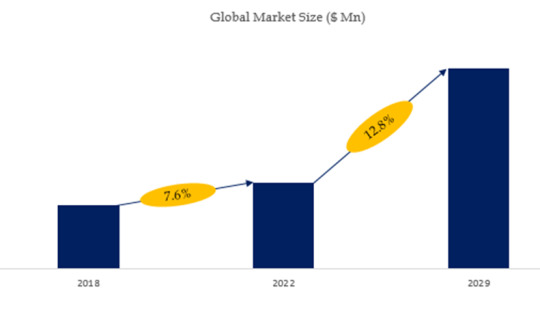
Based on or includes research from QYResearch: Global Drug Eluting Balloons(DEB) Market Report 2023-2029.
Figure. Global Drug Eluting Balloons(DEB) Top 3 Players Ranking and Market Share(Based on data of 2021, Continually updated)

Based on or includes research from QYResearch: 2021 data information of Global Drug Eluting Balloons(DEB) Market Report 2023-2029.
The global key manufacturers of Drug Eluting Balloons(DEB) include B. Braun, Medtronic, etc. In 2021, the global top three players had a share approximately 69.0% in terms of revenue.
About QYResearch
QYResearch founded in California, USA in 2007.It is a leading global market research and consulting company. With over 16 years’ experience and professional research team in various cities over the world QY Research focuses on management consulting, database and seminar services, IPO consulting, industry chain research and customized research to help our clients in providing non-linear revenue model and make them successful. We are globally recognized for our expansive portfolio of services, good corporate citizenship, and our strong commitment to sustainability. Up to now, we have cooperated with more than 60,000 clients across five continents. Let’s work closely with you and build a bold and better future.
QYResearch is a world-renowned large-scale consulting company. The industry covers various high-tech industry chain market segments, spanning the semiconductor industry chain (semiconductor equipment and parts, semiconductor materials, ICs, Foundry, packaging and testing, discrete devices, sensors, optoelectronic devices), photovoltaic industry chain (equipment, cells, modules, auxiliary material brackets, inverters, power station terminals), new energy automobile industry chain (batteries and materials, auto parts, batteries, motors, electronic control, automotive semiconductors, etc.), communication industry chain (communication system equipment, terminal equipment, electronic components, RF front-end, optical modules, 4G/5G/6G, broadband, IoT, digital economy, AI), advanced materials industry Chain (metal materials, polymer materials, ceramic materials, nano materials, etc.), machinery manufacturing industry chain (CNC machine tools, construction machinery, electrical machinery, 3C automation, industrial robots, lasers, industrial control, drones), food, beverages and pharmaceuticals, medical equipment, agriculture, etc.
0 notes
Photo

World No. 1 tennis star Novak Djokovic, record-breaking gymnast Simone Biles, golfing legend Tiger Woods and the France Football Team were among the big winners at the 2019 Laureus World Sports Awards.
In the company of HSH Prince Albert II in Monaco, Novak Djokovic fought off tough competition from the likes of Kylian Mbappe, Eliud Kipchoge and LeBron James to win the Laureus World Sportsman of the Year Award. Novak, who won Wimbledon and the US Open in 2018 after returning from elbow surgery, is now a four-timeLaureus World Sportsman of the Year.
Speaking after receiving his Award, Novak said: “A Laureus Award is what every athlete wants to win, and this one is a huge honor for me. Being among so many sporting greats here tonight, and hearing about the inspirational work Laureus is doing around the world, gives this Award a special meaning for me.
“Last year was an incredible season for me, returning from injury to win Wimbledon and the US Open is something I’ll remember forever. I am delighted and I would like to thank the Laureus Academy for their support.”
The Laureus World Sports Academy – made up of 68 global sporting legends – volunteered their time to vote for the winners in each shortlisted category which recognises sporting achievement in the 2018 calendar year. The Awards were hosted by actor James Marsden and featured entertainment from award-Grammy-nominated singer-songwriter Jorja Smith.
After her record-breaking performance at the gymnastics world championships, in which she won four gold, one silver and one bronze medal, Simone Biles was crowned Laureus World Sportswoman of the Year. Biles, who also won the Sportswoman Award in 2017, made history last year by becoming the first woman to win four all-around world championships. At just 21, she now has a record 14 career world titles.
FIFA World Cup winners France became the first national football team to win a second Laureus World Team of the Year Award, fighting off competition from the world-leading teams including Mercedes AMG Petronas F1, Golden State Warriors and Real Madrid. French coach Didier Deschamps was in Monaco to accept the Award on behalf of the team.
Japan’s first Grand Slam tennis star Naomi Osaka received the Laureus World Breakthrough of the Year Award for her victory in the US Open, where she defeated five-time Laureus Award winner Serena Williams. Osaka, 21, who is now number one in the world, makes history as Japan’s first Laureus Award winner.
Golfing star and ten-time Laureus Nominee Tiger Woods won his third Laureus Award, after winning the Laureus World Sportsman of the Year accolade at the 2000 and 2001 Laureus Awards. The American received the Laureus World Comeback of the Year Award for winning the Tour Championship, his first win in 1,876 days, returning to the game after spinal fusion surgery.
17-year-old American snowboarding sensation Chloe Kim, who became the youngest woman to win a Winter Olympics snowboarding gold medal at the Pyeongchang Winter Olympics, won the Action Sportsperson of the Year Award. Slovak alpine skier Henrieta Farkašová and her guide Natalia Subrtova won theSportsperson of the Year with a Disability Award after becoming the most decorated Winter Paralympian in Pyeongchang with four gold medals in vision-impaired Downhill, Giant Slalom, Super Combined and Super-G, plus silver in Slalom.
Attended by sports stars, celebrities and business leaders from around the world, the Awards also shone a light on the transformational work of Laureus Sport for Good. In 2018, nearly 300,000 young people all over the world directly benefited from more than 160 Laureus Sport for Good-supported programmes in 40 countries, working to end violence, discrimination and disadvantage by using sport as the tool for change.
Yuwa, a sport for development organization that works in the rural region of Jharkhand in northern India, received the Laureus Sport for Good Award for their life-changing work in using football to improve the lives of young girls from disadvantaged communities. Through football, the girls overcome violence, build self-confidence and start to change perceptions of what a girl from a rural village in India is capable of achieving. One of Laureus Sport for Good’s key focus areas is promoting equality, empowerment and safety for young women and girls. Of the 296,300 children and young people Laureus Sport for Good programmes reached worldwide in 2018, 49% were young women and girls.
The Laureus World Sports Academy recognized marathon world record breaker Eliud Kipchoge with the Laureus Academy Exceptional Achievement Award. Kipchoge, who ran the fastest time ever in a marathon in Berlin with a time of 2 hours 1 min 39 seconds, broke the previous record by a massive 1 min 18 seconds.
Legendary football manager Arsène Wenger received the Laureus Lifetime Achievement Award for his contribution to football during his 22 years as manager of Arsenal. During his time there, he famously led ‘The Invincibles’ to an entire season unbeaten, and made a significant contribution to English football through his approach to scouting, training and diets, and his emphasis on an attacking mentality.
Arsène received a guard of honor at the Ceremony from legendary Arsenal captain Cesc Fabregas and football legends Alessandro Del Piero, Luis Figo, Fabio Capello, Didier Deschamps, Cafu and Alex Scott. Arsène’s Award was presented by Cesc Fabregas.
Skiing great Lindsey Vonn’s incredible career was recognized by the Laureus Academy with the Laureus Spirit of Sport Award. The Spirit of Sport Award is given at the discretion of the Academy, to recognize an athlete or team who have achieved remarkable success and displayed a relentless dedication to their sport. The greatest female skier of all time, Vonn recently announced her retirement from the sport. Vonn is one of only two female skiers to win four Overall World Cups and has won a record eight World Cup Downhill titles.
Inspirational Chinese climber Xia Boyu received the most votes in the global Laureus Sporting Moment of the Year public vote. Xia was recognised for his efforts in becoming only the second double-amputee to scale Everest, and the first to reach the summit from the Nepalese side. Joining Xia in the top three Laureus Sporting Moment of the Year Nominees at the Awards in Monaco were; South Africa’s first black Test captain Siya Kolisi and Scottish rugby legend Doddie Weir, who is fighting motor neuron disease.
2 notes
·
View notes